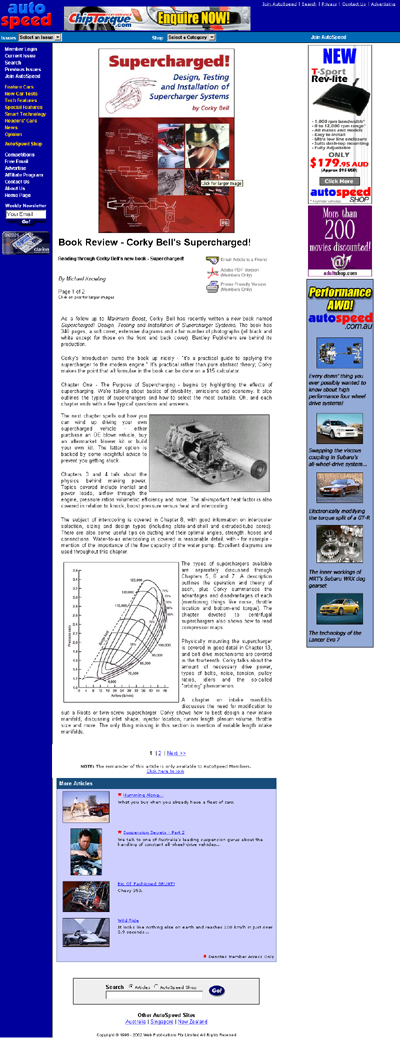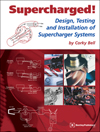|
|
Supercharged!
by Corky Bell
Price: $69.95
|
Reading through Corky Bell's new book - Supercharged!
By Michael Knowling
As a follow up to Maximum Boost, Corky Bell has recently written a new book named Supercharged! Design, Testing and Installation of Supercharger Systems. The book has 346 pages, a soft cover, extensive diagrams and a fair number of photographs (all black and white except for those on the front and back cover). Bentley Publishers are behind its production.
Corky's Introduction sums the book up nicely - "it's a practical guide to applying the supercharger to the modern engine." It's practical rather than pure abstract theory; Corky makes the point that all formulae in the book can be done on a $15 calculator.
Chapter One - The Purpose of Supercharging - begins by highlighting the effects of supercharging. We're talking about basics of drivability, emissions and economy. It also outlines the types of superchargers and how to select the most suitable. Oh, and each chapter ends with a few 'typical' questions and answers.
The next chapter spells out how you can wind up driving your own supercharged vehicle - either purchase an OE blown vehicle, buy an aftermarket blower kit or build your own kit. The latter option is backed by some insightful advice to prevent you getting stuck.
Chapters 3 and 4 talk about the physics behind making power. Topics covered include inertial and power loads, airflow through the engine, pressure ratios volumetric efficiency and more. The all-important heat factor is also covered in relation to knock, boost pressure versus heat and intercooling.
The subject of intercooling is covered in Chapter 8, with good information on intercooler selection, sizing and design types (including plate-and-shell and extruded-tube cores). There are also some useful tips on ducting and their optimal angles, strength, hoses and connections. Water-to-air intercooling is covered in reasonable detail, with - for example - mention of the importance of the flow capacity of the water pump. Excellent diagrams are used throughout this chapter.
The types of superchargers available are separately discussed through Chapters 5, 6 and 7. A description outlines the operation and theory of each, plus Corky summarises the advantages and disadvantages of each (mentioning things like noise, throttle location and bottom-end torque). The chapter devoted to centrifugal superchargers also shows how to read compressor maps.
Physically mounting the supercharger is covered in good detail in Chapter 13, and belt drive mechanisms are covered in the fourteenth. Corky talks about the amount of necessary drive power, types of belts, noise, tension, pulley ratios, idlers and the so-called "orbiting" phenomenon.
A chapter on intake manifolds discusses the need for modification to suit a Roots or twin-screw supercharger. Corky shows how to best design a new intake manifold, discussing inlet shape, injector location, runner length plenum volume, throttle size and more. The only thing missing in this section is mention of variable length intake manifolds.

![[B] Bentley Publishers](http://assets1.bentleypublishers.com/images/bentley-logos/bp-banner-234x60-bookblue.jpg)
